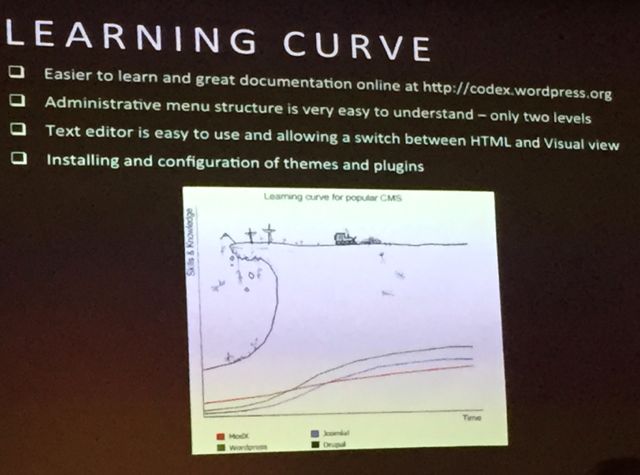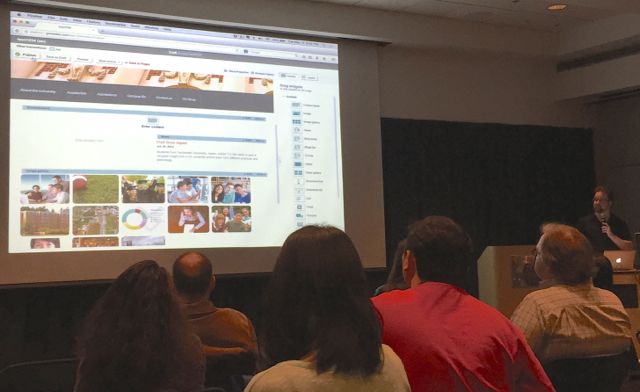On St. Patricks Day, I went to a Vancouver Web Design Meetup that pitted WordPress, Drupal and Sitefinity in a knock-down, drag-and-drop CMS Shootout.

Given the holiday, I was hoping the all-male debaters would wear shiny leprechaun hats and come out with their dukes up like fightin’ Irishmen.
Instead, it was a civilized affair in which each technician presented their CMS with demonstrations, then answered questions from three judges and the audience. The judges would vote for the winning CMS.
When our host, Jaren Scott asked the 178-strong crowd to applaud for their favourite CMS, WordPress had overwhelming response. “We know who the big dog is,” he said.
Team Drupal got smaller, yet respectable applause, and I think two people clapped for Sitefinity.
I know, what’s a Sitefinity?
Here is what was said about WordPress, Drupal and Sitefinity, both paraphrased and quoted.
WordPress
Bhavan Mahal is the Technical Lead at Graphically Speaking and has worked in the Web Development industry for over 6 years.
Clearly, Mahal was speaking to the WordPress choir.
He pretty much told us the wonderful things we already knew about WordPress, so watching his presentation was a little anti-climactic.

His high point was the hilarious illustration of a CMS learning curve that took a deep dig at Drupal.
I spent most of those minutes wondering what kind of beer they were serving at my next destination, The Blarney Stone.
Related: Wix vs Joomla vs WordPress: A Vancouver WordPress Meetup Debate
Drupal
Scott Bell is a designer/developer who has created Drupal sites for the NBA, Time Inc., and FOX.
Bell pointed out the Time cover shown in Bhavan’s presentation and noted the irony that Time is moving from WordPress to Drupal. Ouch, WordPress!

To Bell, the high points of Drupal are:
- The largest developer community in world
- Drupal allows for enterprise level site building
- Security updates are fixed before becoming problems
- Enterprise commercial support from Aquia
- Drupal is knocked for its complexity, and being hard to learn the UI, but that’s because it’s so sophisticated
- Nothing is technically impossible with Drupal
- Contributed modules come from community and custom work
- Can be used as a web service, and can create widgets that are client side.
- Widgets are built with handlebars and JS
- Some are native widgets, not all are service based
- Out of the box framework for flexibility
- Drag and drop modules
- Content creation sidebars good for long form posts
- Fields Autocomplete to connect two fields, which is handy for SEO
- Fields, created through UI, can export to code to deploy to various server
- Images have entity reference field extensions
- Images have drag drop upload and image meta data mapping for auto-populating
- 5 image entities are created to use everywhere
- Images can be cropped on the fly without leaving edit box. Plus, effects!
- You can assign different roles with Workbench or State Machine modules to create workflow
- Content page has powerful custom search API for finding content attached to Apache Solr
- Views – the most used module in Drupal – has query builder writing MySql queries thru Ai, and has a content filter
- You can export Views into code and to a custom module to deploy to different servers
- Field UI – create complex types, where you configure the anatomy of content types
- Endless possibilities for customization of front end and back end
- Drupal is extremely secure, more than other CMS here.
Hey, whitehouse.gov uses Drupal!
Sitefinity
Jason Truman has been the Technical Director of Graphically Speaking for over fourteen years and has worked on hundreds of projects.

He admitted that Sitefinity is an unknown CMS compared to Drupal and WordPress, but said it is equal to Drupal in terms of Worldwide adoption. Why?
- Sitefinity is an enterprise level CMS
- Its extremely large systems do “what WordPress Drupal would struggle to do.”
- Sitefinity was created by Telrik a leading vendor of enterprise software products and owned by Progress.
- Back end and modules are flexible like Drupal
- Sitefinity is built on a MS. net platform
- Sitefinity is not open source or free.
- One time license fees for small biz start at $3000, plus annual updates
- Compete system integration and security, unlike “entry level systems”
- Sitefinity is used by banks, credit unions, and large organizations
- Out of box it has multilingual support, multi-server load balancing, redundancy, fail over, and server syncs
- Includes developer staging, and the workflow is built off the MS.net workflow foundation server
- Sitefinity is focused on mobile responsive, mobile app integrations and integrations with enterprise level tools
- It has mobile app builders within android, apple, and blackberry window integrations with content types
- Sitefinity has integration with marking tools like Salesforce, Magento and Sharepoint
- Unlike WordPress and Drupal, Sitefinity is easy to create content areas on a page
- Photo galleries are chosen from libraries, with content added based on meta data.
- In Sitefinity, content management flows within every other areas in system
- Sitefinity can disallow areas from showing in Mobile view
- It can disallow permissions of the page’s content areas to prevent tampering
- Controls on page are standard with MS.net
- Custom controls can be edited
- Layouts and design can be controlled on page, without knowing html
“Sitefinity has open flexibility and power for regular content mangers to work without much training.”
Here come da’ judges
After the CMS shootout, the judges grilled the presenters.
 Steve Kim is the President of the Boilingpoint Group and is the judging panel chair for the BCAMA Marketer of the Year and a past judge for the Legal Marketing Awards and Social Media Network Awards.
Steve Kim is the President of the Boilingpoint Group and is the judging panel chair for the BCAMA Marketer of the Year and a past judge for the Legal Marketing Awards and Social Media Network Awards.
He acknowledged Sitefinity’s multilingual support and asked, what the other two offered.
WP – WordPress has plugins like Polylang and WPML to give translations
DR – Drupal offers two options: to use a localization module to translate all the screens on the site; Or use a translation module where the workflow passes to the translator
 Sarah Finstad spends her time creating designer marketing strategies as the Director of Marketing and Communications at Regent College, where she actively works with an in-house marketing team to forge new innovative marketing paths in a competitive higher education industry.
Sarah Finstad spends her time creating designer marketing strategies as the Director of Marketing and Communications at Regent College, where she actively works with an in-house marketing team to forge new innovative marketing paths in a competitive higher education industry.
She asked, “Sitefinity has market automation, social, email, and CRM integration. What’s similarly available for Drupal and WordPress?”
DR – Everything you saw there Drupal can do. And Drupal’s free!
WP – There are plugins for marketing like Marketo and Salesforce. Not Sharepoint. And WordPress is free!
 Darrell Hadden is the President of Graphically Speaking, one of the largest web development companies in Vancouver with over 50 web development specialists. He is also Past President of the BC Chapter of the American Marketing Association
Darrell Hadden is the President of Graphically Speaking, one of the largest web development companies in Vancouver with over 50 web development specialists. He is also Past President of the BC Chapter of the American Marketing Association
He asked, “Sitefinity doesn’t really have external plugins so for WordPress and Drupal, what are the pros and cons of plugin libraries, the maximum number of plugins, and vulnerability to hackers of 3rd party plugins?”
SF – You can find some plugins, but mostly you have MS.net controls.
DR – All modules can be customized.
Sarah asked if it’s possible to segregate sections of the site so users can work with particular sections of the site.
DR – Yes, Drupal has built-in permission and roles, and depending on the role, certain access to content. And a builder to create layouts with permissions.
WP – WordPress has built in permissions of 4-5 roles. With plugins you can get deeper with permissions into pages.
SF – Like Drupal, there are built in permissions that can be drilled down to content type, with approval processes. And, it has full versioning with permissions and easy rollbacks.
Kim asked if, for a business person, is Sitefinity priced out of range?
SF – depending on business and your costs. Most businesses have Windows servers already, with those abilities, paying a one time $3000 fee – usually sufficient for small businesses – is not such a big cost. Few pay $10k for licenses. Because of ease of use things, Sitefinity winds up being about the same price as Drupal. Drupal and Sitefinity are both more costly than WP.
(In other words, if you can afford the license, you probably need Sitefinity.)
DR – Once you learn it, you can build a site just like WordPress with templates and the money you pay goes to build features that you’re using.
Hadden asked what two things the technicians liked the most and the least about their CMS
SF – I love the usability and extendability. There’s nothing you can’t do.
What I like the least – Sitefinity doesn’t have a massive community like WordPress to get help from. There are a lot more open source programers compared to MS.net programers.
WP – Best thing about WordPress is plugins and add-ons to do everything I need and beyond.
What I don’t like is the security, especially with servers and hacking, and that should be looked at more.
At which point, WordPress guru Morten Rand-Hendriksen shouted out: “Can I file a dissent to that?”
“You’ll get your chance,” said Scott.
DR – I can’t think of anything I don’t like. I like the community, the events they put on, the clients using Drupal. “I have nothing bad to say about it.”
And the CMS shootout winner is…
Hadden
“I came with the opinion that WordPress is great for small sites. Mid-sized organizations have made decisions about employing open or MS environments, and those companies don’t change midstream. For mid to large enterprise site, Drupal rules. For a .Net shop Sitefinity rules. All 3 win, all 3 lose. You didn’t convince me differently from what I felt when I walked in.”
Finstad
“#1: don’t want the WordPress template look. Templates are not reflective of brand, which is #1 for web design. Between Drupal and Sitefinity, it’s tough. Both have huge positives for marketing automation, which is a huge trend. “I’m leaning toward Sitefinity even with the license fees.”
Kim
“In my business, WordPress is ok. It’s easier for client recognition. Templates we work on with customization. If clients had the budget, I’d go with Drupal or Sitefinity. I have used Sitefinity on a project and found it quite easy for the client and team, as well as our developer team. I’m going with Sitefinity because I’m used to it.”
“So it’s two for Sitefinity and one for nothing,” quipped Jaren Scott.
Applause redux

Then, Scott asked the audience vote with applause about who they thought won the CMS shootout.
Sitefinity got more than before and as Scott said, “really moved the needle on that one.”
Drupal got much more applause than before.
WordPress got about the same amount of applause.
“It sounds like WordPress and Drupal tied it up at the end,” he said. “Scott, it sounds like you moved the needle the most.”
While WordPress held firm, Drupal definitely moved up a notch in the minds of the crowd.
But, the wild card, Sitefinity, probably made the biggest impression on the judges and attendees, both for its power and flexibility. I would call theirs the “luck o’ the Irish” if the company weren’t Bulgarian.
I was left with the opinion that I could and would like to build a site on Drupal. I would love to content manage on Sitefinity too, but it’s probably too difficult for me to build with. I guess I’ll have to drink on it.
The takeaway from this CMS shootout is that WordPress is for personal use and small to mid-sized companies, Drupal is for mid to large-sized companies, and Sitefinity is for huge enterprises.
What do you think? Have you worked with Drupal or Sitefinity? How did it go? And how did the experience compare to WordPress? I’d love to know.

